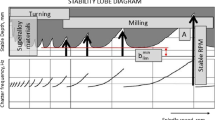Abstract
In this research, we proposed a real-time chatter detection and suppression module for intelligent spindle to increase machining efficiency and processing yield. For early detections of chatters, the relative wavelet packet energy entropy with high sensitivity in the high-frequency band and the local outlier factor (LOF) algorithm were utilized as chatter features and classifications, respectively. Based on the pre-obtained three-dimensional stability lobe diagram (SLD) and a LOF-based trained model, the module could real-time monitor and suppress chatter during machining processes. The module was implemented and experimentally examined with the CNC end-milling machine under five different cutting conditions for verifying the capabilities of real-time chatter identifications and suppressions. It was demonstrated that the module could detect the onset of chatter and suppress it by changing the cutting conditions to avoid damages on the surfaces of working piece due to severe chatters.
Similar content being viewed by others
References
Cao H, Zhang X, Chen X (2017) The concept and progress of intelligent spindles: a review. Int J Mach Tool Manu 112:21–52
Tlusty J, Ismail F (1981) Basic non-linearity in machining chatter. CIRP Ann 30:299–304
Tlusty J, Zaton W, Ismail F (1983) Stability lobes in milling. CIRP Ann 32:309–313
Altintaş Y, Budak E (1995) Analytical prediction of stability lobes in milling. CIRP Ann 44:357–362
Faassen RPH, Wouw NVD, Oosterling J, Nijmeijer H (2003) Prediction of regenerative chatter by modelling and analysis of high-speed milling. Int J Mach Tool Manu 43:1437–1446
Solis E, Peres C, Jiménez J, Alique J, Monje J (2004) A new analytical–experimental method for the identification of stability lobes in high-speed milling. Int J Mach Tool Manu 44:1591–1597
Merdol SD, Altintas Y (2004) Multi frequency solution of chatter stability for low immersion milling. J Manuf Sci Eng 126:459–466
Insperger T, Stépán G (2002) Semi-discretization method for delayed systems. Int J Numer Methods Eng 55:503–518
Du R, Elbestawi M, Ullagaddi B (1992) Chatter detection in milling based on the probability distribution of cutting force signal. J Mech Syst Signal Process 6:345–362
Soliman E, Ismail F (1997) Chatter detection by monitoring spindle drive current. Int J Adv Manuf Technol 13:27–34
Toh C (2004) Vibration analysis in high speed rough and finish milling hardened steel. J Sound Vib 278:101–115
Tangjitsitcharoen S (2009) In-process monitoring and detection of chip formation and chatter for CNC turning. J Mater Process Technol 209:4682–4688
Yoon MC, Chin DH (2005) Cutting force monitoring in the endmilling operation for chatter detection. Proc Inst Mech Eng Part B: J Eng Manu 219:455–465
Yao Z, Mei D, Chen Z (2010) On-line chatter detection and identification based on wavelet and support vector machine. J Mater Process Technol 210:713–719
Sun Y, Zhuang C, Xiong Z (2014) Real-time chatter detection using the weighted wavelet packet entropy, IEEE/ASME Int Conf Adv Intell Mechatron 1652–1657
Sun Y, Xiong Z (2016) An optimal weighted wavelet packet entropy method with application to real-time chatter detection. IEEE/ASME Trans Mechatron 21:2004–2014
Cao H, Lei Y, He Z (2013) Chatter identification in end milling process using wavelet packets and Hilbert–Huang transform. Int J Mach Tool Manu 69:11–19
Yen GG, Lin KC (2000) Wavelet packet feature extraction for vibration monitoring. IEEE Trans Ind Electron 47:650–667
Tangjitsitcharoen S, Saksri T, Ratanakuakangwan S (2013) Advance in chatter detection in ball end milling process by utilizing wavelet transform. J Intell Manuf 26:485–499
Li XQ, Wong YS, Nee AYC (1998) A comprehensive identification of tool failure and chatter using a parallel multi-ART2 neural network. J Manuf Sci Eng 120:433
Lamraoui M, Barakat M, Thomas M, Badaoui ME (2013) Chatter detection in milling machines by neural network classification and feature selection. J Vib Control 21:1251–1266
Hino J, Okubo S, Yoshimura T (2006) Chatter prediction in end milling by FNN model with pruning. JSME Int J C-Mech Sy 49:742–749
Faassen RPH, (2007) Chatter prediction and control for high speed milling: modeling and experiments, Ph.D. Thesis, TU/e
Insperger T, Stépán G (2000) Stability of the milling process. Period Polytech Mech Eng 44:47–57
Stépán G (2001) Modelling nonlinear regenerative effects in metal cutting. Philos Trans A Math Phys Eng Sci 359:739–757
Long X-H, Balachandran B, Mann BP (2006) Dynamics of milling processes with variable time delays. Nonlinear Dyn 47:49–63
Insperger T (2014) Semi-discretization for time-delay systems: stability and engineering applications. Springer-Verlag, New York
Insperger T, Stépán G (2004) Updated semi-discretization method for periodic delay-differential equations with discrete delay. Int J Numer Methods Eng 61:117–141
Bobrenkov O, Butcher E, Mann B (2012) Application of the Liapunov–Floquet transformation to differential equations with time delay and periodic coefficients. J Vib Control 19:521–537
Li Z, Li W, Liu R, (2005) Applications of entropy principles in power systems: a survey, IEEE/PES Transmiss. Distrib. Conf. Exhib. Asia Pacif., Dalian, 1–4
Breunig MM, Kriegel H-P, Ng RT, Sander J (2000) LOF: identifying density-based local outliers, proceed. 2000 ACM SIGMOD. Int Conf Manag Data 29:93–104
Schölkopf B, Williamson RC, Smola AJ, Shawe-Taylor J, Platt J (1999) Support vector method for novelty detection. Adv Neural Inf Proces Syst 12:526–532
Acknowledgements
The authors would like to thank Industrial Technology Research Institute for giving accesses to their facilities and helpful assistances for chatter experiments.
Funding
This work was supported by Ministry of Science and Technology, Taiwan with grant number MOST 106-2221-E-002-133-MY2.
Author information
Authors and Affiliations
Corresponding author
Additional information
Publisher’s note
Springer Nature remains neutral with regard to jurisdictional claims in published maps and institutional affiliations.
Rights and permissions
About this article
Cite this article
Yao, YC., Chen, YH., Liu, CH. et al. Real-time chatter detection and automatic suppression for intelligent spindles based on wavelet packet energy entropy and local outlier factor algorithm . Int J Adv Manuf Technol 103, 297–309 (2019). https://doi.org/10.1007/s00170-019-03551-2
Received:
Accepted:
Published:
Issue Date:
DOI: https://doi.org/10.1007/s00170-019-03551-2




